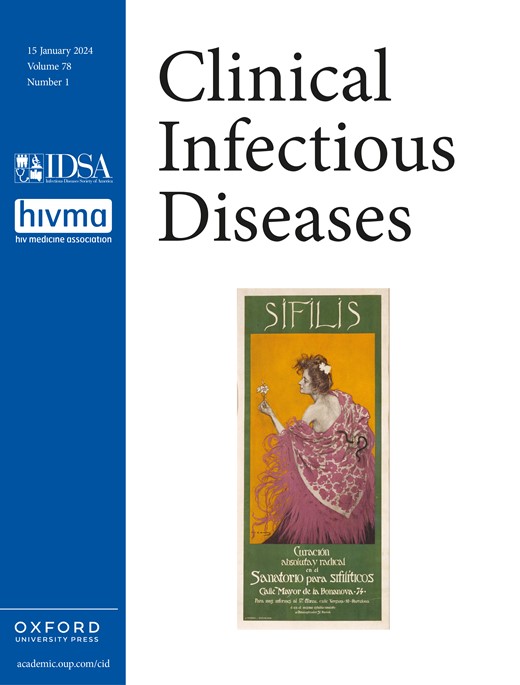埃塞俄比亚社区卫生工作者以家庭为基础的儿童接触调查和TPT管理方法的有效性:一项实用的集群随机试验。
IF 8.2
1区 医学
Q1 IMMUNOLOGY
引用次数: 0
摘要
背景:结核病预防治疗(TPT)在预防结核病(TB)方面非常有效,但实施不力。我们的目的是确定与以设施为基础的护理标准相比,以家庭为基础的接触者管理是否能提高密切接触者中TPT的吸收。方法我们在埃塞俄比亚奥罗米亚18个初级卫生机构的年龄<15岁的结核病患者密切接触者中进行了一项实用的集群随机试验。医疗机构按1:1随机分为基于家庭或基于医疗机构的接触管理。干预措施由社区卫生工作者(CHWs)实施,并与结核病焦点人员分担任务。主要终点是每个TB客户在TPT上发起的年龄<15岁的联系人数量的集群水平比率。结果:家庭治疗组(每名结核病患者1.7名接触者)与医院治疗组(每名结核病患者1.3名接触者)相比,家庭治疗组(每名结核病患者1.3名接触者)每名结核病患者接受TPT治疗的儿童接触者平均数量高出40%;比率为1.4,95%可信区间[CI]: .7-2.7)。在护理连续体中,假设每户2.1名儿童<15岁,在两个组中分别有73%和63%的儿童完成了TPT。1名儿童TPT治疗失败,2名儿童分别在家庭和机构治疗组因药物相关不良反应停止TPT治疗。结论社区卫生工作者以家庭为基础的接触管理使接受TPT治疗的儿童人数增加了40%,对治疗结果没有负面影响。虽然统计上不显著,但在更大范围内,发现并开始接受TPT治疗的儿童人数的增加有可能大大减轻埃塞俄比亚和其他地方儿童结核病的负担。临床试验注册编号:nct04369326。本文章由计算机程序翻译,如有差异,请以英文原文为准。
Effectiveness of a Home-based Approach to Child Contact Investigation and TPT Management by Community Health Workers in Ethiopia: A Pragmatic Cluster-randomized Trial.
BACKGROUND
Tuberculosis preventive treatment (TPT) is highly effective at preventing tuberculosis (TB) disease but is poorly implemented. We aimed to determine whether home-based contact management improves TPT uptake among close child contacts compared to the facility-based standard of care.
METHODS
We conducted a pragmatic cluster-randomized trial among close contacts of TB clients aged <15 years in 18 primary health facilities in Oromia, Ethiopia. Facilities were randomized 1:1 to home-based or facility-based contact management. The intervention was conducted by community health workers (CHWs) and task-shared with TB focal persons. The primary endpoint was the cluster-level ratio of the number of contacts aged <15 years initiated on TPT per TB client.
RESULTS
The cluster-level mean number of child contacts initiated on TPT per TB client was 40% higher in the home-based (1.7 contacts per TB client) versus facility-based arm (1.3 contacts per TB client; rate ratio 1.4, 95% confidence interval [CI]: .7-2.7). In the care continuum, assuming 2.1 children <15 years per household, 73% and 63% of children completed TPT in the 2 arms, respectively. One child failed TPT and 2 children discontinued TPT due to drug-related adverse reactions in the home-based and facility-based arms, respectively.
CONCLUSIONS
Home-based contact management by CHWs increased the number of children initiated on TPT by 40% without negative effects on treatment outcomes. Though not statistically significant, on a larger scale, the increased number of children identified and initiated on TPT has the potential to substantially reduce the burden of pediatric TB in Ethiopia and elsewhere.
CLINICAL TRIALS REGISTRATION
NCT04369326.
求助全文
通过发布文献求助,成功后即可免费获取论文全文。
去求助
来源期刊

Clinical Infectious Diseases
医学-传染病学
CiteScore
25.00
自引率
2.50%
发文量
900
审稿时长
3 months
期刊介绍:
Clinical Infectious Diseases (CID) is dedicated to publishing original research, reviews, guidelines, and perspectives with the potential to reshape clinical practice, providing clinicians with valuable insights for patient care. CID comprehensively addresses the clinical presentation, diagnosis, treatment, and prevention of a wide spectrum of infectious diseases. The journal places a high priority on the assessment of current and innovative treatments, microbiology, immunology, and policies, ensuring relevance to patient care in its commitment to advancing the field of infectious diseases.
 求助内容:
求助内容: 应助结果提醒方式:
应助结果提醒方式:


